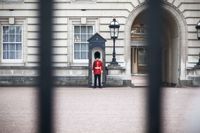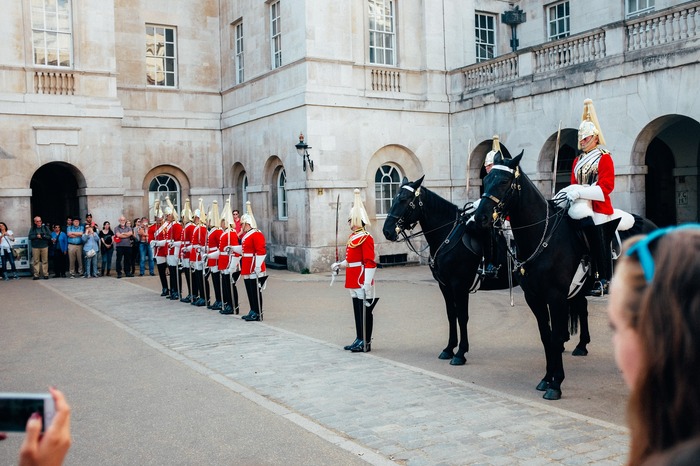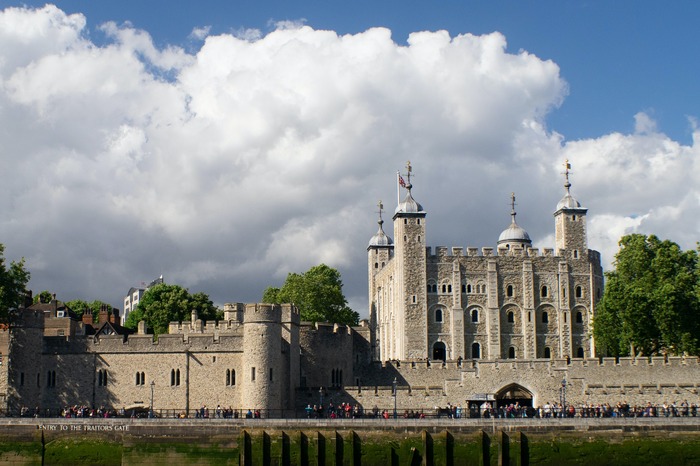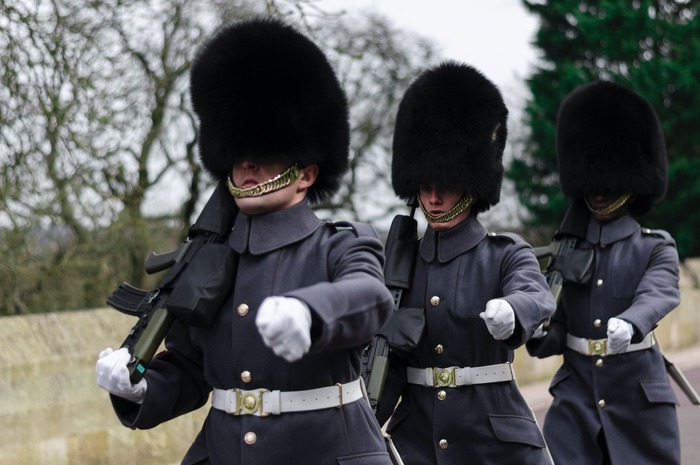
When and where to see the Changing of the Guard in London?
Changing the Guard (or Guard Mounting) is one of London's most iconic tourist attractions. Rooted in British military history, this age-old tradition allows spectators to witness the replacement of the famous royal guards' regiments. It is a dazzling display of military excellence and discipline that fascinates visitors from around the world, offering a colorful spectacle that symbolizes the stability and grandeur of the British monarchy.
Changing the Guard at Buckingham Palace, undoubtedly the most famous, attracts crowds of tourists eager to see this majestic ceremony up close. However, there are other, more intimate Changing the Guard ceremonies across London. Indeed, several historic landmarks in the British capital, such as the Horse Guards Parade, the Tower of London, and Windsor Castle, also host this millennia-old ceremony.
Immerse yourself in the fascinating world of British royal traditions by attending Changing the Guard in London, an unmissable experience that combines history, spectacle, and a unique immersion into the living heritage of Great Britain.
Attending Changing the Guard is a rare opportunity to see the royal guards in action, adding a touch of authenticity and majesty to the royal atmosphere that pervades the city. The soldiers, dressed in their distinctive red tunics and famous bearskin hats, embody the prestige and tradition of the British monarchy, offering an unforgettable experience for spectators.
advertisement
Plan your visit by checking the ceremony calendar on the official British Army website. It is advisable to arrive early to secure a good spot and fully enjoy the spectacle. The best viewpoints are in front of the Buckingham Palace gates or on the steps of the Victoria Memorial, as well as along The Mall where the guards parade.
Be aware that the ceremonies can be canceled in case of rain. It is therefore wise to check the weather forecast before heading out to avoid any disappointment. In adverse weather conditions, Changing the Guard is often postponed to ensure the safety of participants and spectators.
Changing the Guard at Buckingham Palace
The Buckingham Palace, a living symbol of the British monarchy, has been the official residence of the British royal family in London since 1837. It was the residence of Queen Elizabeth II and her husband, Prince Philip, Duke of Edinburgh, until their deaths. Today, it is King Charles III who resides there.

Changing the Guard ceremony takes place at the main entrance of the palace, accompanied by a military band. The royal guard's band plays a varied repertoire mixing military music and contemporary melodies, much to the delight of spectators.
Parades to the soundtracks of famous films such as James Bond, Star Wars, or the series Game of Thrones have already taken place, adding a playful touch to this ancestral ceremony.
The royal guards: uniforms and regiments
The royal guards are recognizable by their traditional red tunic in summer, or a long gray coat in winter, and the famous bearskin helmet.
Traditionally made from Canadian black bear fur, these hats are about 45 centimeters high and have been worn by the guards since the Battle of Waterloo in 1815. Introduced in the 17th century, the red tunics have become an emblematic symbol of the British royal guard regiments.

These guards are part of the five infantry regiments of the Household Division:
- The Grenadier Guards: recognizable by their red tunics with evenly spaced buttons and their famous bearskin hats.
- The Coldstream Guards: also wear red tunics, but their buttons are in groups of two. They also sport a red plume on the right side of their bearskin hat.
- The Scots Guards: identifiable by their red tunics with buttons in groups of three and a white plume on the left side of their hat.
- The Irish Guards: their red tunics have buttons in groups of four, and they wear a St. Patrick's shamrock on their hats, with a blue plume on the right side.
- The Welsh Guards: they are distinguished by their buttons in groups of five and a green and white plume on the left side of their hats.
And the two cavalry regiments of the Household Cavalry:
- The Life Guards: recognizable by their red tunics and white-crested helmets, they are one of the two ceremonial cavalry regiments.
- The Blues and Royals: recognizable by their blue tunics and red-crested helmets, they form the second regiment of the ceremonial cavalry.
The uniforms of these regiments are not only spectacular; they also carry traditions and stories deeply rooted in British military heritage. Every detail, from the buttons to the plumes, tells a story and helps distinguish one regiment from another.
King Charles III is the colonel-in-chief of all the regiments of the Household Division, a tradition that strengthens the bond between the monarchy and the British army.
The ceremony at Buckingham Palace: calendar 2025, dates and times
To the sound of the band, the soldiers whose turn it is to guard begin the changing ritual by gathering at St. James's Palace and Wellington Barracks from 10:30 am, then head - on foot or on horseback - to Buckingham Palace, passing through Birdcage Walk and Spur Road.
They join the soldiers already present and begin the official march in front of the main entrance of the palace - located near the gates of Green Park (Canada Gate). Once the new guard is in place, the old guard leaves the palace to return to Wellington Barracks - located just next to St James's Park.
If King Charles III is in the palace (the royal flag flies above the palace), four guards stand in front of its doors - compared to only two guards if the king is not present.
It is a rather long and monotonous ceremony.
In summary: what you need to know
| Days and times | Every Monday, Wednesday, Friday, and Sunday at 11 AM |
| Route | The guards depart from St. James's Palace and Wellington Barracks to Buckingham Palace |
| Duration | The ceremony starts at 10:45 AM and lasts about 45 minutes, with the official change at 11 AM |
| Price | Free |
Plan to arrive at least 1 hour before the parade starts and try to position yourself near the palace gates or the barriers along the route - or on the steps of the Victoria Memorial fountain.
Tube stations: Green Park, Hyde Park Corner, St. James's Park, and Victoria | Bus lines: 2, 6, 9, 11, 13, 14, 19, 22, 36, 38, 52, 148, 211, 239, 390, C1, and C10
It is recommended to check the ceremony calendar on the official Household Division website shortly before your visit, as dates may change due to special events or weather conditions.
Changing the Guard at Horse Guards Parade
Located in the heart of London, Horse Guards Parade is the headquarters of the Household Cavalry, the cavalry of the British royal household. This ceremony takes place near Whitehall, between Trafalgar Square and Parliament, and offers a unique opportunity to see the famous mounted guards up close.
Horse Guards Parade is also the site of many other ceremonies and events, such as Trooping the Colour, the annual military parade celebrating the official birthday of the sovereign.
Changing the Guard at Horse Guards Parade is an iconic ceremony, less known than the one at Buckingham Palace, but just as impressive. It is a fascinating demonstration of British military discipline and heritage, marked by sumptuous uniforms and ancient rituals.
The mounted guards: Life Guards and Blues and Royals
The changing of the mounted guard (Horse Guards Parade or Changing The King's Lifeguard) is carried out by the two cavalry regiments of the British Army, the Household Cavalry :
- The Life Guards: recognizable by their red tunics and white-crested helmets, they are one of the two ceremonial cavalry regiments.
- The Blues and Royals: recognizable by their blue tunics and red-crested helmets, they form the second regiment of the ceremonial cavalry.

The ceremony at Horse Guards Parade: calendar 2025, dates and times
The new guard departs every day from Hyde Park Barracks at 10:28 am on weekdays (Monday to Saturday) and at 9:28 am on Sunday. They ride towards the esplanade of Horse Guards at Whitehall Palace, parading through Hyde Park Corner, Wellington Arch, Constitution Hill and The Mall, to arrive at Horse Guards Parade at 11 am (10 am on Sunday), and gather with the horses of the old guard.
The ceremony, which lasts about 30 minutes, begins with a formal exchange of words between the incoming and outgoing guards, followed by an inspection of uniforms and equipment. Unlike Changing the Guard at Buckingham Palace, the ceremony at Horse Guards Parade takes place without a musical band, offering a more solemn and intimate atmosphere.
To fully enjoy the ceremony, it is advisable to arrive early and position yourself along The Mall to see the guards pass or on the large esplanade of Horse Guards Parade for a direct view of the changing.
Between 10 am and 4 pm, the entrance of Horse Guards is guarded by two mounted sentinels, with a change every hour.
Another Changing the Guard takes place simultaneously on the other side of the barracks - it is not possible to observe both ceremonies at the same time.
In summary: practical information
| Days and times | Monday to Saturday at 11 am and Sunday at 10 am |
| Location | On the esplanade of Horse Guards Parade |
| Duration | About 30 minutes |
| Price | Free |
Changing the Guard at Horse Guards Parade is a good alternative to Changing the Guard at Buckingham Palace because it is less crowded!
Tube stations: Charing Cross, Embankment and Westminster | Bus lines: 3, 11, 12, 24, 26, 53, 87, 88, 159 and 453
The troop review at Horse Guards Parade
The troop review (The 4 O'Clock Parade or Dismounting Ceremony) also takes place at Horse Guards Parade. This ceremony occurs in the small courtyard at the back of the horse stables. During the review, the foot and mounted guards are inspected one by one by a senior officer. After the inspection, the mounted guards return the horses to the stables for the night.
After the inspection, two guards remain on duty until the gates close at 8 PM. Another guard stays on duty until the gates open at 7 AM the next morning.
| Days and times | Every day at 4 PM |
| Location | At Horse Guards Parade, in the small courtyard at the back of the horse stables |
| Duration | Approximately 15 minutes |
| Price | Free |
Tube stations: Charing Cross, Embankment, and Westminster | Bus lines: 3, 11, 12, 24, 26, 53, 87, 88, 159, and 453

Changing the Guard at the Tower of London
Changing the Guard at the Tower of London is a lesser-known but equally impressive ceremony compared to those at Buckingham Palace or Horse Guards Parade. This ceremony takes place inside one of London's oldest fortresses, offering a unique and historical experience.

The Tower of London is not just a ceremonial site; it is also a historic fortress and a legendary prison. It houses the famous Beefeaters, the Tower's guards, who are iconic figures in British history.

The ceremony at the Tower of London: calendar 2025, dates and times
During Changing the Guard at the Tower of London, an officer inspects the guards in front of the Byward Tower. The ceremony begins with a rigorous inspection of the guards who are taking over and those who are being relieved. The Tower of London guards are members of the infantry regiments of the Household Division, who are also responsible for the security of the Crown Jewels, the most precious artifacts of the British monarchy, displayed at the Tower of London.
To fully enjoy the ceremony and other attractions at the Tower of London, it is advisable to arrive early. Tickets can be purchased online to avoid queues.
Changing the Guard at the Tower of London is distinguished by its unique historical setting. The Byward Tower, dating back to the 13th century, serves as the backdrop for this ceremony, during which visitors can closely observe the traditional uniforms and military rituals that have been preserved for centuries.
In summary: what you need to know
| Days and times | Every day |
| Location | Within the Tower of London, in front of the Byward Tower |
| Duration | Approximately 30 minutes |
| Price | Accessible only to visitors with a ticket for the Tower of London |
It is recommended to check the official Tower of London website for exact times, as they may vary.
Tube stations: Tower Hill, Aldgate, and Monument | Bus lines: 15, 42, 78, 100, and RV1 | River shuttle station: Tower Pier
Changing the Guard at Windsor Castle
The Windsor Castle is one of the most iconic royal residences in the United Kingdom. Located to the west of London, this historic castle has been used by the British royal family for over 900 years. It is particularly known as one of Queen Elizabeth II's favorite residences, where she stayed most weekends, from March to April, and one week in June during the prestigious Royal Ascot horse race.
advertisement
The castle hosts numerous royal events and state ceremonies. Attending Changing the Guard in this historic setting is a unique and memorable experience.

In addition to Changing the Guard, visitors can explore the magnificent gardens and the State Apartments, which are open to the public at certain times of the year.
Windsor Castle is the oldest and largest inhabited royal residence in the world. It is a strong symbol of British history and tradition.
The royal guards: uniforms and regiments
As at Buckingham Palace, the soldiers who perform Changing the Guard at Windsor Castle are part of the five infantry regiments of the Household Division:
- The Grenadier Guards: recognizable by their red tunics with evenly spaced buttons and their famous bearskin hats.
- The Coldstream Guards: also wear red tunics, but their buttons are in pairs. They also sport a red plume on the right side of their bearskin hats.
- The Scots Guards: identifiable by their red tunics with buttons in groups of three and a white plume on the left side of their bearskin hats.
- The Irish Guards: their red tunics have buttons in groups of four, and they wear a St. Patrick's shamrock on their hats, with a blue plume on the right side.
- The Welsh Guards: they are distinguished by their buttons in groups of five and a green and white plume on the left side of their hats.
And the two cavalry regiments of the Household Cavalry:
- The Life Guards: recognizable by their red tunics and white-plumed helmets, they are one of the two ceremonial cavalry regiments.
- The Blues and Royals: recognizable by their blue tunics and red-plumed helmets, they form the second ceremonial cavalry regiment.

The ceremony at Windsor Castle: calendar 2025, dates and times
To the sound of the band, the new guard soldiers leave Victoria Barracks on foot. They march in step through the streets of Windsor: along Sheet Street and High Street, up to the junction with the statue of Queen Victoria - before entering the castle. At the end of the ceremony, the old guard leaves the castle to return to Victoria Barracks.
The ceremony takes place in the quadrangle of the castle, a majestic setting that adds to the solemn and impressive nature of the event.
To get a good vantage point, it is recommended to arrive at least an hour before the ceremony starts.
Changing the Guard at Windsor Castle is a spectacular demonstration of British military discipline, very similar to that at Buckingham Palace, but much less crowded.
In summary: practical information
| Days and times | Every Tuesday, Thursday, and Saturday at 11am |
| Route | From Victoria Barracks to the inner courtyard of Windsor Castle, passing through Sheet Street and High Street |
| Duration | Approximately 45 minutes |
| Price | Accessible only to visitors with a Windsor Castle ticket |
Although Changing the Guard ceremony is free, entry to Windsor Castle requires the purchase of a ticket. It is recommended to book tickets online in advance to avoid queues.
It is recommended to check the official Windsor Castle website for exact times as they may vary due to special events and weather conditions.
Windsor Castle is located about 1 hour by train from Waterloo Station in London. The Windsor & Eton Central and Windsor & Eton Riverside stations are the closest to the castle.